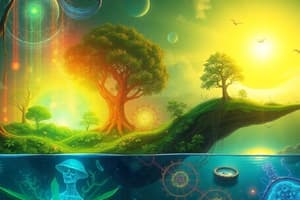Podcast
Questions and Answers
Which pathway describes the process of creating larger molecules from smaller subunits?
Which pathway describes the process of creating larger molecules from smaller subunits?
- Catabolic
- Metabolism
- Anabolic (correct)
- Photosynthesis
Oxidation involves the gain of electrons.
Oxidation involves the gain of electrons.
False (B)
What is the main role of chlorophyll in photosynthesis?
What is the main role of chlorophyll in photosynthesis?
To absorb light energy for photosynthesis
The fluid-filled space within the inner membrane of the mitochondria is called the ______.
The fluid-filled space within the inner membrane of the mitochondria is called the ______.
Match the terms related to metabolic processes with their definitions:
Match the terms related to metabolic processes with their definitions:
Which of the following statements best describes the role of enzymes in metabolism?
Which of the following statements best describes the role of enzymes in metabolism?
Photosynthesis occurs in mitochondria.
Photosynthesis occurs in mitochondria.
Define the term 'heterotroph'.
Define the term 'heterotroph'.
Which pigment acts as a backup to chlorophyll A by absorbing different wavelengths of light?
Which pigment acts as a backup to chlorophyll A by absorbing different wavelengths of light?
The absorption spectrum measures the effectiveness of a wavelength in photosynthesis.
The absorption spectrum measures the effectiveness of a wavelength in photosynthesis.
What is the process by which plants convert carbon dioxide into organic compounds?
What is the process by which plants convert carbon dioxide into organic compounds?
The process by which excited electrons leave the reaction center and break down water molecules is called ______.
The process by which excited electrons leave the reaction center and break down water molecules is called ______.
Which of the following is NOT part of the light-dependent reactions?
Which of the following is NOT part of the light-dependent reactions?
Match the following terms with their functions:
Match the following terms with their functions:
What is the main function of the electron transport system in photosynthesis?
What is the main function of the electron transport system in photosynthesis?
The Calvin-Benson Cycle includes three main phases: carbon fixation, ______, and regeneration.
The Calvin-Benson Cycle includes three main phases: carbon fixation, ______, and regeneration.
Flashcards
Absorption Spectrum
Absorption Spectrum
The amount of each wavelength of light absorbed by a pigment.
Action Spectrum
Action Spectrum
The effectiveness of different wavelengths of light in driving photosynthesis.
Photosystem
Photosystem
A light-gathering complex in chloroplasts that contains chlorophyll and accessory pigments.
Photolysis
Photolysis
Signup and view all the flashcards
Electron Transport Chain
Electron Transport Chain
Signup and view all the flashcards
Light-Dependent Reactions
Light-Dependent Reactions
Signup and view all the flashcards
Light-Independent Reactions (Calvin Cycle)
Light-Independent Reactions (Calvin Cycle)
Signup and view all the flashcards
Carbon Fixation
Carbon Fixation
Signup and view all the flashcards
Metabolism
Metabolism
Signup and view all the flashcards
Enzymes
Enzymes
Signup and view all the flashcards
Anabolic
Anabolic
Signup and view all the flashcards
Catabolic
Catabolic
Signup and view all the flashcards
Activation energy
Activation energy
Signup and view all the flashcards
Chloroplast
Chloroplast
Signup and view all the flashcards
Thylakoid
Thylakoid
Signup and view all the flashcards
Mitochondria
Mitochondria
Signup and view all the flashcards
Study Notes
Photosynthesis and Cellular Respiration
- Metabolic pathways: Biological processes involving matter and energy, such as cellular respiration and photosynthesis.
- Photosynthesis: Stores energy from the sun in glucose; glucose is then released during cellular respiration.
- Photosynthesis → Cellular Respiration → Photosynthesis: A cyclical process where the product of each step is used as input for the next.
Metabolic Pathways and Enzymes
- Metabolism: Sum of all processes within a cell.
- Cellular respiration and photosynthesis representation via chemical equations, depicting net reactions only.
- Enzymes: Protein catalysts aiding reactions, ensuring metabolic processes occur.
- Activation energy: Energy required to initiate a reaction.
- Enzymes reduce activation energy needed for reactions to begin.
- Enzymes enhance reaction efficiency and reaction rates.
- Anabolic: Reactions/pathways build larger molecules from smaller ones (positive).
- Catabolic: Reactions/pathways break down large molecules into smaller ones (negative).
- Activation energy - necessary for starting reaction; reactions cannot naturally proceed without energy.
Oxidation and Reduction
- Oxidation: Atom/molecule loses electrons, resulting in energy loss.
- LEO: Losing electrons = Oxidation.
- Reduction: Atom/molecule gains electrons, resulting in energy gain.
- GER: Gaining electrons = Reduction.
- Oxidation and reduction occur simultaneously.
The Chloroplast
- Chloroplast: Site of photosynthesis in plant cells.
- Parts of the chloroplast: Stroma - fluid-filled matrix within; thylakoid - flattened sac-like structures organized into grana within stroma.
- Membranes surround the stroma, providing compartments for photosynthesis.
The Mitochondria
- Mitochondria: Site of cellular respiration in plant and animal cells.
- Matrix: Fluid-filled inner compartment containing necessary chemicals/proteins for carbohydrate breakdown, ATP generation. (ATP: adenosine triphosphate, cellular energy).
- Two membranes surround the matrix.
- Mitochondria assist in cellular respiration.
Photosynthesis
- Autotrophs: Organisms making their own food (e.g., plants).
- Heterotrophs: Organisms that consume other organisms for food (e.g., animals).
- Photosynthesis: Process of producing food (glucose) using light energy, carbon dioxide, and water.
- Photosynthesis reactants: Carbon dioxide (CO2) and water (H2O).
- Photosynthesis products: Glucose (C6H12O6) and oxygen (O2).
- Chlorophyll absorbs light energy, driving photosynthesis.
Absorption Spectra of Pigments
- Pigments absorb specific wavelengths, reflecting others. Chlorophyll A is vital for photosynthesis.
- Chlorophyll B and carotenoids are accessory pigments, widening the range of absorbed light.
The Reactions of Photosynthesis
- Light-dependent reactions: Light energy is converted into ATP and NADPH (high energy molecule).
- Occurs in thylakoid membranes within chloroplasts.
- Water is split into oxygen, hydrogen ions (H+), and electrons during these reactions.
- Water breakdown is called photolysis.
- Light-independent reactions: Use ATP and NADPH to convert CO2 into glucose.
- Occurs in the stroma of chloroplasts.
Light-Independent Reactions (Calvin Cycle)
- CO2 enters a cycle of chemical reactions forming glucose.
- ATP and NADPH provide energy/reducing power for the Calvin Cycle.
- Cycle regenerates starting materials for further CO2 fixation, sustaining the cycle.
- Three basic steps: Carbon fixation, reduction, and regeneration. Three phases overall.
Factors Affecting Photosynthesis
- Light: Rate increases with light intensity and diminishes at a certain point.
- Temperature: Optimal temperature range exists for optimal photosynthesis rate, reactions slowdown and stop at extreme temperatures.
- Carbon dioxide: Rate increases with carbon dioxide concentration and diminishes at a certain point.
Studying That Suits You
Use AI to generate personalized quizzes and flashcards to suit your learning preferences.
Related Documents
Description
Test your knowledge on the processes of photosynthesis and cellular respiration. This quiz covers metabolic pathways, the role of enzymes, and the cyclical nature of energy transformation in living organisms. Great for students studying biology concepts related to energy metabolism.




